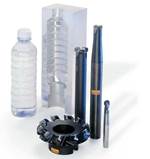How to Optimize Moldmaking Milling Operations
The lead angle of your cutter has a dramatic effect on not only the chip that you generate, but also the cutting forces in both the axial and the radial directions.
The lead angle of your cutter has a dramatic effect on not only the chip that you generate, but also the cutting forces in both the axial and the radial directions. All of this can affect your overall productivity. There are many milling lead angle concepts on the market today and each is designed to perform a specific task.
A square shoulder cutter produces the majority of its cutting forces in the radial direction, making this design best suited for not only a square shoulder, but machining components where vibration could be an issue.
With the square shoulder cutter, you get no chip-thinning effect. The programmed feed rate per tooth is exactly equal to the actual chip thickness. This makes a square shoulder milling cutter a smart choice for components with thin surfaces, in cases where you have unstable fixturing; machines having weaker spindles; and, of course, when you need to produce a 90-degree shoulder.
Of note, the 90-degree lead angle is commonly used in face milling. It can easily perform the task, but it’s not commonly the most productive or cost-effective choice. A cutter with a 45-degree lead angle should be your first choice for face milling.
An important rule to remember is that as the lead angle of your cutter decreases, so does the chip thickness. Due to this, you have the opportunity to increase your feed rate to compensate. This makes the 45-degree lead angle cutter a smart choice for general-purpose face milling operations, reducing vibration on long overhangs and machining short chipping materials—such as grey cast iron.
Today, many companies are using a strategy employing light cutting depths at very high feed rates. Using a very small lead angle—such as 10 degrees—should be your first choice in machining with low depths of cut.
As we mentioned, with a square shoulder, you get no chip-thinning effect. However, as the lead angle decreases, the chip thins. As we decrease the chip angle all the way from square to 10 degrees, the chip is thinned out to almost nothing.
Here, you can increase your table feed and achieve the proper chip thickness. Milling cutters that have a very small lead angle are a smart choice for high feed machining with low cutting depths, applications with long and weak setups and effective hole making using all three axes.
Related Content
-
MMT Chats: 5 in 5 with Best Tool and Engineering
MoldMaking Technology Editorial Director Christina Fuges reveals 5 best practices for improving efficiencies within shops...in 5 minutes. Our guest is Joe Cherluck, President of Best Tool and Engineering in Clinton Township, Michigan.
-
How to Use Scientific Maintenance for More Accurate Mold and Part Troubleshooting
Discover how adopting scientific maintenance approaches helps improve mold lifespan, minimize failures, and optimize production outcomes.
-
How to Solve Hot Runner Challenges When Molding with Bioresins
A review of the considerations and adaptations required to design hot runners and implement highly productive injection molding operations.














